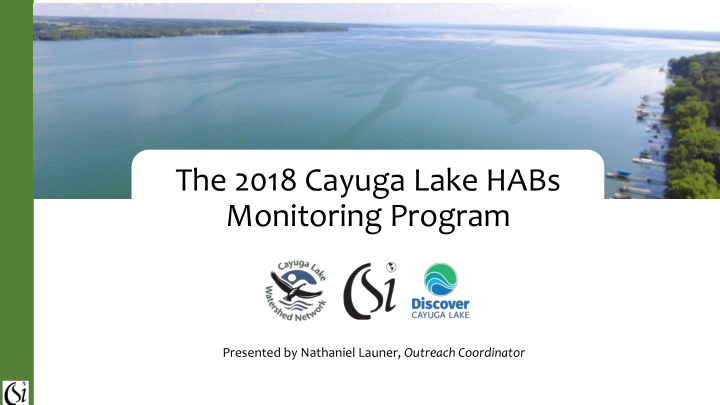



The 2018 Cayuga Lake HABs Monitoring Program Presented by Nathaniel Launer, Outreach Coordinator
Frequency of Cyanobacteria Blooms (HABs) on Cayuga Lake 2018 Not Tested 10 for microcystin 9 Blooms with microcystin levels 8 Identified by the Community Science Institute less than drinking Number of Cyanobacteria Blooms per day water limit 7 of 0.3 ug/ L 6 Blooms with 5 microcystin levels greater than 0.3 4 ug/ L and less than recreation 3 limit of 4 ug/ L 2 Blooms with 1 microcystin levels ranging 0 from 4 ug/ L to 7/2/2018 7/12/2018 7/22/2018 8/1/2018 8/11/2018 8/21/2018 8/31/2018 9/10/2018 2,533 ug/ L Cayuga Lake 2018 HABs Monitoring Season
When did blooms have the highest toxin levels in 2018? - blooms sampled in September had higher toxin concentrations than those sampled in July and August.
Mapping 30% Of Cayuga Lake Shoreline Monitored Northwestern Quadrant Northeastern Quadrant Weekly Over 75 volunteers in the first year! Sheldrake Point Southwestern Quadrant Southeastern Quadrant
Occurrence of confirmed cyanobacteria blooms on Cayuga Lake appeared to increased in 2018 compared to the previous year, though much of this may be due to improved monitoring efforts. Nearly all blooms on Cayuga Lake in 2018 with toxin levels above state drinking water and recreation limits contained the cyanobacteria Microcystis. A sharp rise in bloom toxin levels was observed in later summer months on Cayuga Lake in 2018. On Cayuga Lake in 2018, 77% of the blooms with microcystin concentrations above 4 ug/ L occurred in the northern half of the lake. Monitoring is essential for 1. Assessing the risk that cyanobacteria blooms may or may not present. 2. Data collection to support risk management
We Need Your Help This Summer Protecting Cayuga Lake from Harmful Algal Blooms (HABs)! Who can volunteer? • Anyone! Lake shore homeowners and avid boaters and anglers are especially encouraged to participate. What does being a HABs Harrier entail? • Attend a two hour HABs identification and sampling workshop in June. • Survey assigned length of shoreline once a week, mid- July through September. • Collect HABs samples and transport them to CSI lab for further analysis. • Be available to respond to HABs sightings reported by members of the public We want to reach at least 50% of lakeshore coverage in 2019! Community Science Institute Cayuga Lake Watershed Network Discover Cayuga Lake info@communityscience.org programs@cayugalake.org (607) 327-5253 607-257-6606 607-319-0475
The Community Science Institute presents: Water and Community Nutrients in the Watershed, Unusual Weather, and Harmful Algal Blooms: A Public Conversation Sharon Anderson , Environmental Team Leader, Tompkins County Cornell Cooperative Extension Saturday, March 23rd Moderator 1:00 - 4:00 PM Panelists will provide brief overviews of their topics prior to an open discussion The beautiful Lakeside Room at the Inns of Aurora Greg Boyer, Director, Great Lakes Research Consortium and Professor of Biochemistry, SUNY - College of Environmental Science and Forestry 391 Main St. Aurora, NY Cyanobacteria , Blooms, and Nutrients Refreshments will be provided by the Inns of Aurora Mark W. Wysocki, Senior Lecturer in Meteorology and New York State Climatologist, Cornell University Floods, Droughts, and Temperature Swings: Not Your Grandfather’s Weather We invite you to come and listen to the discussion, and we encourage you Stephen Penningroth , Executive Director, Community Science Institute (CSI) Long-Term Nutrient Data Sets in the Cayuga Lake Watershed to participate! Greg Albrecht, Agricultural Environmental Management (AEM) Coordinator, NYS Soil & Water Conservation Committee and NYS Dept. of Agriculture and Markets Nutrient Management and Conservation Practices by Farms
Recommend
More recommend